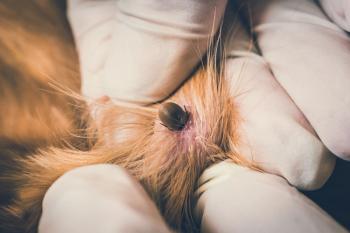
Zoonotic diseases in cats can be easily avoided with proper prevention, care
Estimates indicate there are approximately 73 million owned cats in the United States with 30 percent of American households having at least one. Cats are host to a variety of parasites, including several that are zoonotic.
Estimates indicate there are approximately 73 million owned cats in the United States with 30 percent of American households having at least one. Cats are host to a variety of parasites, including several that are zoonotic. Unfortunately, many owners are not aware of these diseases and the simple steps that can be taken to avoid them. This article focuses on the common zoonotic parasites of cats and their importance to the health of the cat and the owner.
Table 1: Selected broad-spectrum anthelmintics for use in cats
Hookworms
Hookworms in cats are represented by two species – Ancylostoma tubaeforme and Ancylostoma braziliense. Their prevalence among cats in the United States is virtually unknown. However, we do know their geographic distribution differs within the country. Ancylostoma braziliense is limited to tropical and subtropical regions of the southeastern United States while A. tubaeforme is more generally distributed. The host range for these two parasites also differs in that A. tubaeforme is primarily found in cats while A. braziliense can infect both cats and dogs.
The life cycle of these two parasites is similar and may be direct or indirect with a paratenic host. Adult parasites live in the anterior portion of the small intestine. Life expectancy of A. tubaeforme has been reported to be 18 months to two years while that for A. braziliense is shorter lasting four to eight months. A single adult female A. braziliense can produce 200 to 6,000 eggs per day although the number declines as the worm ages. Eggs of both species are passed with the feces of the host (Photo 1). First-stage larvae develop within the egg, hatch, and molt to become second-stage larvae which subsequently molt to become infective third-stage larvae (L3). Development to the infective L3 can occur in as little as one week. Cats can then be infected by one of several routes. Larvae may penetrate the skin and enter the circulatory system where they are carried to the lungs. Larvae then enter the alveoli, migrate up the trachea and are swallowed, maturing to the adult stage in the gastrointestinal tract. The prepatent period is 13-27 days.
Photo 1: Unembryonated hookworm egg. This could be either Ancylostoma tubaeforme or Ancylostoma braziliense.
Cats can also become infected by ingesting infective L3 or rodent paratenic hosts. Under these circumstances, the larvae penetrate the wall of the stomach or proximal small intestine but do not undergo extraintestinal migration prior to returning to the gut lumen to mature.
Clinical presentation for these two hookworms differ. The main clinical signs associated with A. tubaeforme infections are weight loss and a regenerative anemia, which goes along with the fact hookworms are blood-feeding parasites. Death can also occur if the rate of larval acquisition is high. Conversely, A. braziliense is less pathogenic with very little hemorrhage at the sites where adults attach. Clinical disease is usually not encounterd.
Several products are available for the treatment of hookworm infections in cats (Table 1). Preventing infections by reducing predation by cats is desirable, but often difficult to achieve because of the strong instinctive nature of this behavior. Periodic anthelmintic treatment is the most effective means of control in adult cats.
Photo 2: Cutaneous larval migrans.
While A. tubaeforme is more important to the health of the cat, A. braziliense is more important as a cause of cutaneous larval migrans (CLM) in humans. On contact with unprotected skin, L3 penetrate the epidermis. However, the larvae cannot penetrate the basement membrane and are, therefore, confined to the lower epidermis where they migrate aimlessly. As they migrate, the larvae release proteolytic enzymes which leads to an intense inflammatory reaction. Within one to two weeks, the characteristic reddened, serpiginous, and intensely pruritic skin eruptions are visible (Photo 2). Because the inflammatory reaction is not directed against the larvae themselves, the skin eruption tends to be located some distance from where the larvae actually are. Even though CLM is self-limiting, the intense pruritis usually necessitates some treatment to lower the risk of secondary bacterial infections.
Roundworms
Roundworms in cats are also represented by two species - Toxascaris leonina and Toxocara cati. Toxascaris leonina is not associated with clinical signs in cats and is rarely zoonotic. Conversely, T. cati is not only zoonotic but is also considered to be the most common and the most important intestinal nematode parasite of cats. Adult T. cati live in the small intestine of the host, producing eggs that are passed with the feces (Photo 3). They are extremely prolific, producing as many as 24,000 eggs per day.
The life cycle of T. cati is direct or indirect with a paratenic host. Once eggs are passed in the feces, larval development and production of infective L3 occurs. This takes place entirely within the egg and can be complete in three to four weeks. Eggs are extremely resistant to adverse environmental conditions and can remain viable in the soil for months to years. Cats can then be infected by one of several routes including ingestion of larvated eggs. Once eaten, the egg hatches and the larvae undergo a hepatic-pulmonary migration prior to returning to the small intestine and maturing. The prepatent period for this route is about two months.
Photo 3: Unembryonated egg of Toxocara cati.
Cats can also be infected through ingestion of rodent paratenic hosts or by transmammary transmission. Larvae acquired by either of these routes do not migrate beyond the intestinal wall and the prepatent period for these infections is about three weeks. Of the three possible routes of infection, transmammary transmission is considered by many to be the most important although ingestion of paratenic hosts may be a primary means by which infections are maintained in cats that are allowed to hunt.
Kittens infected with T. cati may present with an enlarged abdomen and failure to thrive, clinical signs similar to those found in puppies infected with Toxocara canis. Vomiting and diarrhea have also been reported. Migration through the lungs and upper respiratory tract can lead to coughing and sneezing. Several products are available for the treatment of T. cati infections in cats (Table 1). As with hookworms, preventing exposure of cats to roundworms in endemic areas can be quite difficult and periodic treatment remains the most effective means of controlling feline toxocariasis in adult cats.
Table 2: Chemotherapeutic treatment of feline toxoplasmosis.
Roundworms are the primary cause of visceral larva migrans (VLM) and ocular larva migrans (OLM) in humans, far more serious diseases than CLM. Most cases are thought to be caused by T. canis, the dog roundworm, because most cats tend to cover up their feces which limits exposure. However, T. cati is capable of causing both disease syndromes. Infection occurs when humans ingest embryonated eggs from contaminated environments. Eggs hatch and the larvae spread throughout the body via the circulatory system. They may migrate anywhere, but the liver, lungs, brain, heart and eyes (OLM) tend to be the primary target organs. Most cases are subclinical and self-limiting; however, serious disease can occur with symptoms dependent upon which tissues or organs are damaged. VLM occurs most often in children under 4 years of age while OLM tends to occur more frequently in older children (up to 13 years of age).
Larval migrans syndromes are not reportable diseases in the United States, so how many human cases occur each year is not known. However, as many as 4,000 requests for serodiagnostic confirmation of presumptive human cases of toxocariasis occur annually. Most cases of larva migrans can be prevented. The Centers for Disease Control and Prevention recommends that pet owner education focus on prevention and include: (1) a description of the parasites, the early signs of illness, and when pets are at the greatest risk for infection: (2) how these parasites cause disease in humans, especially children whose habits put them at increased risk; (3) how properly timed dewormings can protect the animal as well as the owner; (4) the need for regular diagnostic fecal examinations; (5) the need for prompt collection and disposal of feces; and (6) the need to keep children away from areas that may be contaminated with cat feces.
Table 3: Recommendations for the prevention of Toxoplasma gondii in cats and humans.
Toxoplasmosis
Toxoplasma gondii is a coccidian parasite with a rather complex, indirect life cycle. Felids, the only definitive hosts for the parasite, shed unsporulated oocysts in the feces. By 24 hours at room temperature (25 degrees C), oocysts have sporulated, becoming infectious for the intermediate host. Most mammals (including cats and humans) and birds can serve as intermediate hosts. After a period of asexual development, tissue cysts containing bradyzoites develop. Other intermediate hosts or the definitive host can become infected when ingesting the bradyzoites. The prepatent period is three to 10 days with peak oocyst excretion between days five and eight. Cats can also become infected by ingesting sporulated oocysts. Transplacental transmission, in both intermediate and definitive hosts, can also occur if the dam is infected during pregnancy.
Infections with T. gondii in cats tend to be inapparent. Clinical infections are more common in stressed, concurrently ill, or immunocompromised cats. Cats may present with fever, dyspnea, coughing, myalgia, vomiting, lymphadenopathy, retinochoroiditis or granulomatous panuveitis. No drugs are approved for the treatment of feline toxoplasmosis; however, among available options, clindamycin has become the drug of choice (Table 2).
Humans become infected through one of three ways - consumption of undercooked meat, ingestion of oocysts, or transplacental transmission if infection is acquired during pregnancy. In the United States, pork appears to be the most likely source of tissue cysts for humans as cattle are naturally resistant to the parasite and other infected meats (e.g., sheep, goat) are not consumed in significant amounts. Chickens, which are susceptible to infection, are not considered a primary source of infection because it is often frozen and not usually eaten rare. Transplacental transmission can also occur and is responsible for congenital toxoplasmosis, of which approximately 3,000 cases are reported annually in the United States. The severity of the disease depends on the age at which the fetus became infected with the most serious effects occuring when women acquire infection during weeks 10-24 of gestation.
Preventing infection with T. gondii in cats and humans depends on avoiding exposure to sporulated oocysts or tissue cysts. Oocysts have not been isolated from the fur of infected cats; therefore, it is unlikely infections would be acquired by petting a cat. High risk individuals should, however, avoid exposure to cat feces and employ good personal hygiene as well as proper food preparation techniques (Table 3, p. 7).
Cryptosporidiosis and Giardiosis
Cryptosporidiosis is associated with several species and genotypes of the coccidian parasite Cryptosporidium. This parasite has a direct life cycle and reproduces in the epithelial cells of the small intestinal mucosa of the host. Oocysts are shed in the feces and are immediately infectious when passed. Cats become infected when ingesting oocysts directly or in contaminated food or water. The prepatent period is five to six days and the patent period is seven to 10 days. Cats that present with cryptosporidiosis generally have recurring bouts of diarrhea and typically have an underlying immunosuppressive disorder. Treatment is usually designed to replace fluid losses resulting from the diarrhea. Parmomycin has been used to treat cats with this parasite, but severe complications (e.g., renal failure) may result.
Until recently, cryptosporidiosis in humans and animals was thought to be caused by one species of parasite - Cryptosporidium parvum. Recent studies, however, indicate that several species and genotypes of Cryptosporidium exist including C. felis of cats. The role of these different species/genotypes in human infections is unclear. However, C. felis has been identified in both immunocompromised as well as immunocompetent humans. Prudence dictates that feces from Cryptosporidium-infected cats be considered a potential human health risk.
Preventing cryptosporidiosis depends on good hygiene. Oocysts are destroyed by heating to over 60 degrees C or by dessication. Routine washing of bedding using a household washer and dryer is thought sufficient to destroy oocysts. Cages or litter boxes should be washed with hot soapy water, rinsed and dried thoroughly. Cats should not be allowed to roam to minimize contact with contaminated water sources.
Giardiosis is associated with various species of the protozoan parasite Giardia. The life cycle of this parasite is also direct. Cysts are passed in the feces and transmitted to the next host through direct ingestion or in contaminated food or water. Trophozoites leave the cyst and reside within the lumen of the small intestine where they reproduce, eventually producing cysts which are excreted. Cats with clinical disease typically present with diarrhea. Metronidazole has traditionally been the treatment of choice for this parasite.
As for Cryptosporidium, several genotypes (and possibly species) appear to exist. While it is clear that zoonotic species/genotypes exist, it is unclear what role the species infecting cats plays in human infections. Therefore, like Cryptosporidium, prudence dictates that feces from Giardia-infected cats be considered a potential human health risk. Prevention measures are also the same as those described for Cryptosporidium.
Preventing human disease
Pet ownership bears certain responsibilities. With ownership comes the responsibility for the well-being of the pet as well as the welfare and health of the owners, the neighborhood and the community. Most pet owners are unaware that their cat may carry parasites capable of infecting people. Because of their access to the pet-owning public, knowledge and training, and role in the human-animal bond, veterinarians are in an ideal position to provide advice on zoonotic parasites and contribute an important public service. In fact, surveys of physicians indicate they look to veterinarians to not only control zoonotic pathogens in animals, but to also educate themselves as well as their patients. This service would include recommending regular fecal examinations for pets, providing well-timed anthelmintic treatments, and counseling clients on potential public health hazards and precautionary measures which should be used.
Dr. Ballweber is an associate professor in the College of Veterinary Medicine at Mississippi State University. She joined the faculty in 1993 where her research focuses on parasites of ruminants and llamas, as well as a variety of wildlife. She also shares responsibility for teaching veterinary parasitology to veterinary students. She received her veterinary degree from Oregon State University (OSU) in 1992 and a master's degree in parasitology from the University of Wyoming in 1982 and a master's degree in veterinary science (epidemiology) from OSU in 1989.
Suggested Reading
Newsletter
From exam room tips to practice management insights, get trusted veterinary news delivered straight to your inbox—subscribe to dvm360.




